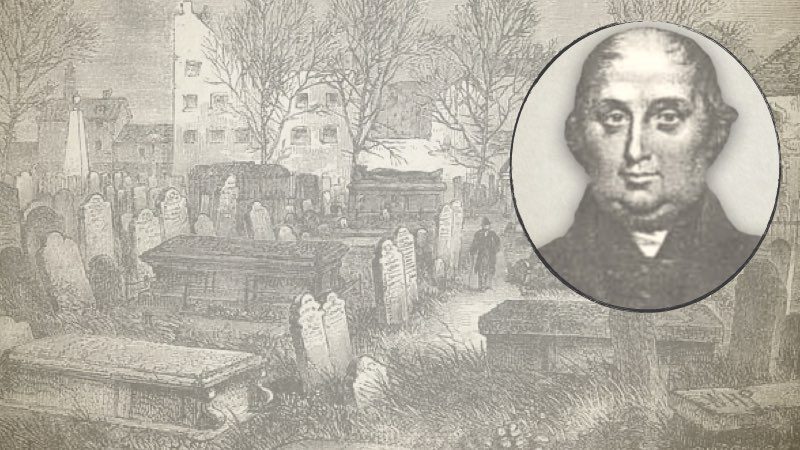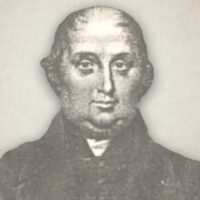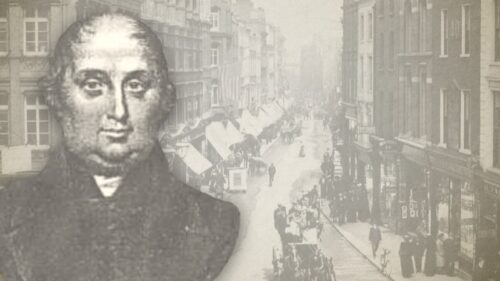
The Life And Death Of John Stevens
J. A. Jones, “Bunhill Memorials: Sacred Reminiscences Of Three Hundred Ministers And Other Persons Of Note, Who Are Buried In Bunhill Fields, Of Every Denomination” (1849):[1]
John Stevens, Baptist. Sacred is the memory of the Rev. John Stevens, who exchanged mortality for immortal vigour, and for a crown of life, after a long affliction of excruciating pain from the stone, &c., under which he enjoyed great supports, lively joys, and strong comforts; composedly and resignedly waiting and wishing for the uninterrupted enjoyment of his covenant God, whom living, he delighted to proclaim; whom dying he glorified, October 17, 1778, aged 56.—Rev. 14:13, “Blessed are the dead which die in the Lord, from henceforth; yea, saith the Spirit, that they may rest from their labours; and their works do follow them.”
“Look up my friends, pant towards the eternal hills,
Those heavens are fairer than they seem;
There pleasures all sincere glide on in crystal rills:
There not a dreg of guilt defiles,
Nor grief disturbs the stream.
That Canaan knows no noxious thing.
No cursed soil, no tainted spring.
No roses grow on thorns, no honey wears a sting.”
Head Stone, E. and W. 81,—N. and S. 35.
John Stevens was born about the year 1722, at a small village near Exmouth, in Devonshire. Being bound apprentice to a ropemaker, in Plymouth, he received his first religious impressions under the celebrated Andrew Kinsman. He soon commenced preaching, and coming up to London., be was introduced to the Tabernacle, in Moorfields, and officiated there for some time. Afterwards embracing the sentiments of the Baptists, he received an invitation to succeed the Rev. George Braithwaite, as pastor of the Baptist Church, in Devonshire Square, and was ordained there, in May, 1750. Upon the resignation of Dr. Gill, he was chosen, in conjunction with Mr. Brine, to carry on the Wednesday evening lecture, in Great Eastcheap. At his setting out in the ministry, Mr. Stevens was exceedingly popular; had a crowded congregation wherever he preached, and which continued for several years; when being removed from Devonshire Square, he engaged a newly-erected Meeting-house, in Redcross Street, and formed those persons that gathered to him into a church, to whom he preached till his death. He endured a long bodily affliction, and was subjected to the most excruciating pain; from which he was released, Oct. 17, 1778, aged 66.—W.
——————————-
[1] The reader is encouraged to visit Bunhill Fields, a nonconformist cemetery located at 38 City Road, London, England.
John Stevens (1776-1847) was a Strict and Particular Baptist preacher. In 1811 he was appointed pastor of the church meeting at Grafton Street, London. He is the author of “Help For The True Disciples Of Immanuel”, a work which uproots the pernicious teachings of Andrew Fuller. However, throughout the course of his ministry, he entertained some dangerous ideas. Foremost was the notion that the human nature of Christ is pre-existent, a position that cannot be maintained scripturally or logically. In 1809, he also published “Doctrinal Antinomianism Refuted, And The Old Law Established In A New Relation.” This book was written in opposition to William Gadsby’s position that the gospel is the rule of conduct for the believer’s life, not the moral law. However, rather than overthrowing Gadsby’s teachings, he wound up undermining the gospel he sought to defend. Nevertheless, in the whole, Stevens “was an unflinching advocate for the doctrines of grace”.




